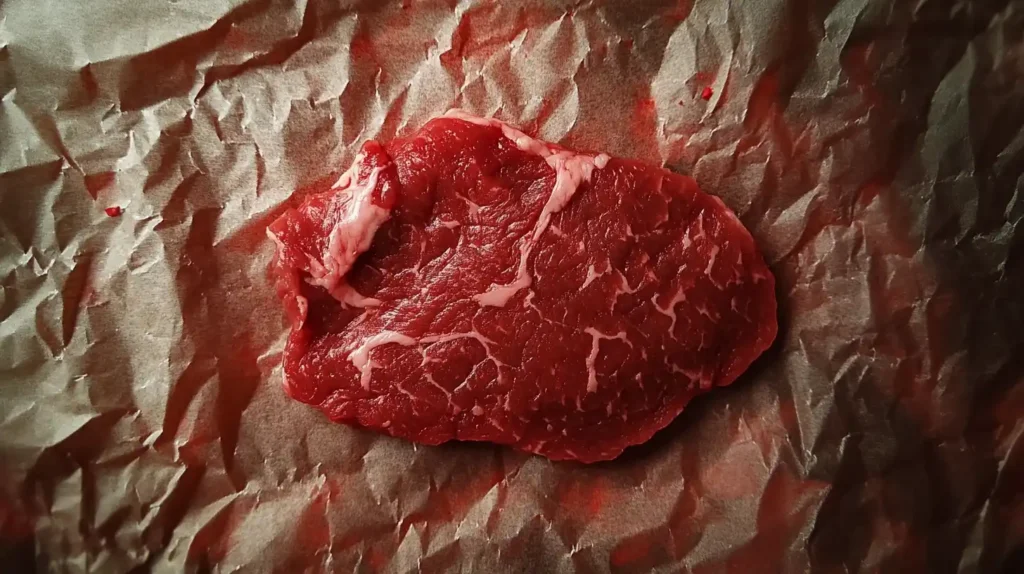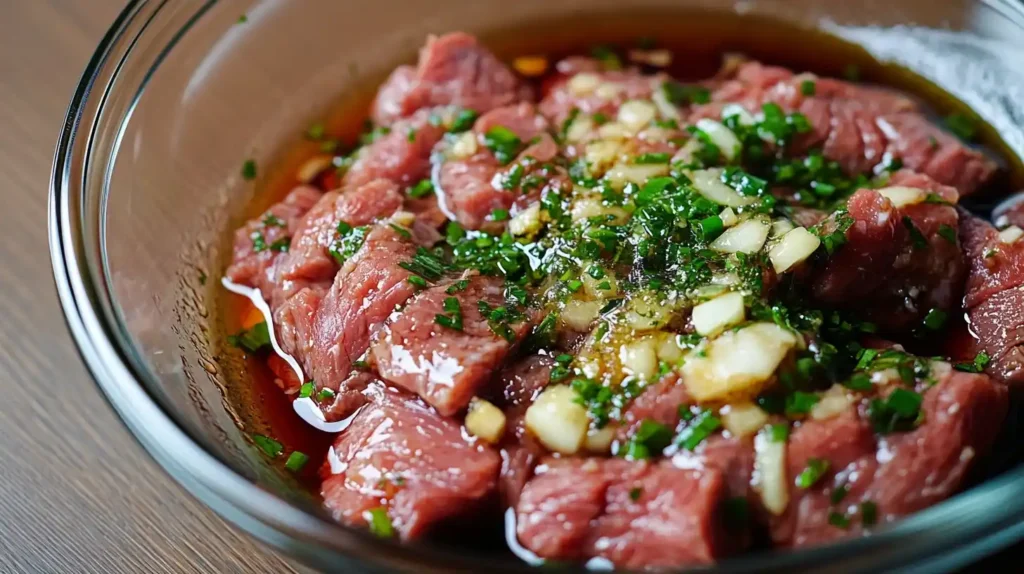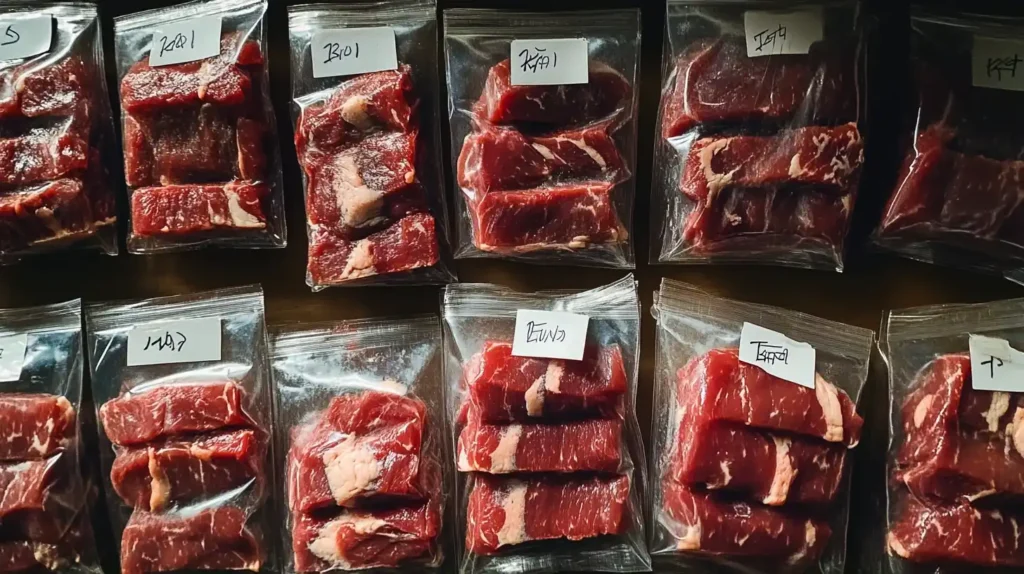Have you ever wondered what thinly sliced beef is called? Many people know it as shaved beef or beef shavings. This thin, tender meat is used in many famous dishes, from hearty sandwiches to stir-fries. It’s a favorite because it cooks quickly and absorbs flavors like a sponge.
Using thinly sliced beef can make your meals taste better while saving you time in the kitchen. With a little practice, you can master the art of slicing beef thinly at home. If you’re not confident, you can even ask your butcher to do it for you. In this article, you’ll learn all about this special ingredient, including how to use it, store it, and even which recipes work best.
Table of contents
What is Thinly Sliced Beef?
Thinly sliced beef, often called shaved beef or beef shavings, is beef that’s cut into very thin slices. These slices are usually paper-thin, which makes them cook quickly and absorb flavors easily. This makes shaved beef a perfect choice for busy home cooks and chefs who want to prepare fast, tasty meals.
Unlike thick cuts of beef, it is much more versatile. You can use it in dishes from all over the world, including stir-fries, soups, sandwiches, and even salads. It works well because the thin slices cook evenly, and the flavors mix into the meat faster.
Many people confuse thinly sliced beef with deli roast it, but they’re not the same. While thinly sliced beef is raw and meant for cooking, deli roast beef is already cooked and usually used for cold sandwiches.
Popular Cuts for Thinly Sliced Beef

Not all beef cuts are ideal for slicing thinly. Some cuts are better because they are naturally tender, flavorful, or easy to work with. Here are the most popular choices for thinly sliced beef:
- Sirloin: This cut strikes a balance between tenderness and flavor, making it great for stir-fries and sandwiches.
- Ribeye: Known for its rich marbling, ribeye has a buttery texture that’s perfect for grilling or pan-searing.
- Top Round: This is a lean and affordable cut that works well for recipes with strong marinades.
- Flank Steak: Flank steak has a bold, beefy flavor and is excellent for dishes like fajitas or stir-fried beef.
- Tenderloin: As the name suggests, this cut is one of the most tender. It’s a pricier option but perfect for special occasions.
Why These Cuts Work Best
These cuts are popular because they can hold their shape and texture even when sliced very thinly. Most of them are also easy to find at your local butcher or grocery store, which makes them convenient choices.
Quick Tip:
If you’re unsure which cut to buy, ask your butcher for recommendations. You can even request that they slice the beef thinly for you, which saves time and effort.
Culinary Uses of Thinly Sliced Beef
Cooks across the globe use it in diverse ways. Its ability to blend seamlessly into various recipes makes it invaluable in many cuisines. Here are some popular uses:
Western Dishes
- Philly Cheesesteak: it combined with onions and melted cheese creates a classic sandwich.
- French Dip: Juicy beef slices served with a flavorful au jus sauce for dipping.
Asian Cuisine
- Korean Bulgogi: Marinated slices of beef grilled over high heat deliver bold flavors.
- Japanese Sukiyaki: Thin beef simmered with vegetables in a savory and sweet broth.
- Vietnamese Pho: Tender slices of raw beef added to hot, fragrant noodle soup.
Mediterranean Influence
- Carpaccio: Raw beef slices drizzled with olive oil and lemon juice.
- Beef Tagliata: Seared beef slices served with fresh arugula and Parmesan.
These examples highlight the endless possibilities thinly sliced beef offers in the kitchen.
How to Slice Beef Thinly at Home
Slicing beef thinly at home might sound tricky, but it’s easier than you think. With the right tools and techniques, you can achieve professional results every time. Thinly sliced beef not only looks great but also cooks evenly, ensuring your dishes turn out perfect. Follow these simple steps to master the skill.
Step 1: Chill the Beef
First, partially freeze the beef for 30–40 minutes. The goal is to make the meat firm without freezing it solid. This step helps you create clean, even slices. If the meat is too soft, it will squish under the knife, and your slices will be uneven.
Step 2: Use a Sharp Knife
Next, select a sharp knife, preferably one designed for slicing meat. A dull knife can tear the meat and make cutting harder. Always cut against the grain of the meat. This method ensures that each slice is tender and easy to chew.
Step 3: Secure the Cutting Surface
Place your cutting board on a non-slip surface, or use a damp towel underneath to keep it steady. A secure surface prevents accidents and makes slicing safer.
Step 4: Slice with Precision
Hold the beef firmly but avoid pressing too hard. Start at one end and slice slowly, applying even pressure. Focus on consistency to ensure that every piece is the same thickness. Thin, even slices cook more evenly and look better in your final dish.
Quick Tips:
- If you’re new to slicing meat, practice on smaller cuts to build your confidence.
- For more even slices, try investing in a meat slicer if you plan to do this often.
- In case you don’t have time, ask your butcher to do the slicing for you. They have the tools to make it quick and precise.
Marinating Thinly Sliced Beef for Extra Flavor
Marinating thinly sliced beef is one of the best ways to bring out its flavor and enhance its texture. A good marinade not only makes the beef taste amazing but also tenderizes it, ensuring each bite is juicy and flavorful. Thankfully, marinating beef is quick and easy with a few key steps.

Why Marinate Thinly Sliced Beef?
Because it absorbs flavors quickly, you don’t need to marinate it for long. Even 15 to 30 minutes can make a big difference. However, for richer flavors, you can let it soak overnight. The marinade also helps prevent the beef from drying out during cooking.
Step-by-Step Marination Process
- Choose Your Marinade Ingredients
Start with a base such as soy sauce, Worcestershire sauce, or olive oil. Then, add flavor boosters like garlic, ginger, lemon juice, or spices. Sweeteners like honey or brown sugar can balance savory marinades. - Combine and Coat the Beef
Mix all the ingredients in a bowl or zip-lock bag. Add the beef slices and ensure every piece is coated evenly. Massage the beef gently to help the flavors soak in. - Refrigerate the Marinated Beef
Place the bowl or bag in the fridge while the beef marinates. Always keep the meat chilled to prevent bacteria growth. - Cook Immediately After Marinating
Once the marination time is up, cook the beef right away. Prolonging the process after marination can make the meat mushy.
Quick Marinade Ideas
- Asian-Inspired: Soy sauce, sesame oil, ginger, garlic, and brown sugar.
- Citrus-Based: Lemon juice, olive oil, garlic, thyme, and pepper.
- Bold and Smoky: Worcestershire sauce, paprika, mustard, and honey.
Pro Tips for Success:
- Don’t marinate the beef for too long, as it can overpower the natural flavor.
- Always discard leftover marinade used with raw meat for safety reasons.
- Experiment with different herbs and spices to create unique flavor profiles.
Storing Thinly Sliced Beef Correctly
Proper storage is essential to keep thinly sliced beef fresh, safe, and flavorful. Without the right techniques, the meat can spoil quickly or lose its texture. Thankfully, storing beef the correct way is simple and can extend its shelf life significantly.

Storing in the Refrigerator
If you plan to use the beef within a few days, the refrigerator is the best option. Here’s how to store it properly:
- Use Airtight Containers
Place the beef in a tightly sealed container or a zip-lock bag. This prevents air from drying out the meat or causing freezer burn. - Keep It Cold
Store the beef at the back of the fridge, where temperatures are most consistent. Use the meat within two to three days for the best quality. - Label the Container
Always label the container with the date so you know when you stored it. This helps prevent guessing and ensures you use the beef before it spoils.
Freezing Thinly Sliced Beef
For longer storage, freezing is a better choice. When stored correctly, thinly sliced beef can last up to three months in the freezer.
- Portion the Meat
Divide the beef into smaller portions before freezing. This makes it easier to thaw only what you need for a recipe. - Wrap It Well
Wrap the beef in plastic wrap or aluminum foil, then place it in a freezer-safe bag. Squeeze out as much air as possible to prevent freezer burn. - Label and Date
Write the date and contents on the bag. Frozen beef stays good for up to three months, but it’s always helpful to know how long it’s been stored.
Thawing Frozen Beef Safely
When it’s time to use frozen beef, you’ll want to thaw it properly:
- In the Refrigerator: Place the frozen beef in the fridge and let it thaw slowly overnight. This is the safest method and preserves the meat’s quality.
- In Cold Water: For faster thawing, submerge the wrapped beef in cold water, changing the water every 30 minutes. Cook immediately after thawing.
- Avoid Room Temperature: Never thaw beef on the counter, as this can promote bacterial growth.
Quick Tips for Storage Success:
- Avoid storing beef near raw poultry or seafood to prevent cross-contamination.
- Don’t refreeze thawed beef, as it can lose its flavor and texture.
- Always cook refrigerated or thawed beef within a few days to maintain freshness.
Health Benefits of Thinly Sliced Beef
Thinly sliced beef is not only a delicious ingredient but also a nutrient-packed addition to your meals. It provides essential vitamins and minerals that support overall health. Whether you’re adding it to a stir-fry, a sandwich, or a soup, thinly sliced beef can contribute to a well-balanced diet.
High-Quality Protein Source
Beef is a great source of high-quality protein, which helps build and repair muscles. Protein is essential for maintaining strong bones, healthy skin, and energy levels throughout the day. Just one serving of thinly sliced beef can give you the boost you need.
Rich in Iron and Zinc
Thinly sliced beef is also rich in iron, a mineral that helps your body carry oxygen through your blood. Eating beef can prevent iron-deficiency anemia, which causes fatigue and weakness. Additionally, beef contains zinc, which supports your immune system and helps your body heal wounds faster.
Packed with Essential Vitamins
This ingredient provides key B vitamins, including:
- Vitamin B12: Improves brain function and supports nerve health.
- Vitamin B6: Boosts energy levels and helps your body break down protein.
- Niacin: Promotes healthy skin and aids digestion.
A Healthy Choice in Moderation
Although beef offers many health benefits, it’s best to enjoy it in moderation. Red meat is high in saturated fat, which can raise cholesterol levels if consumed excessively. Pair your thinly sliced beef with fresh vegetables, whole grains, and healthy fats to create a balanced meal.
Quick Tips for Healthier Eating:
- Choose lean cuts like sirloin or tenderloin to reduce fat content.
- Avoid over-seasoning the beef with salt; instead, use herbs and spices for flavor.
- Practice portion control by sticking to a 3–4 ounce serving size.
Frequently Asked Questions (FAQs)
Here are some common questions people ask about thinly sliced beef, along with clear and simple answers to help you understand more about this versatile ingredient.
What is thinly sliced beef commonly called?
Thinly sliced beef is often referred to as shaved beef or beef shavings. These terms describe the paper-thin slices of beef that are perfect for quick-cooking dishes.
Can I use frozen thinly sliced beef?
Yes, frozen it works very well in recipes. Just make sure you thaw it properly before cooking. The safest way is to thaw it in the refrigerator overnight, though you can also use the cold-water method if you’re in a hurry.
How does thinly sliced beef differ from deli roast beef?
Thinly sliced beef is raw and meant to be cooked, while deli roast beef is pre-cooked and seasoned. Deli roast beef is typically used in cold sandwiches, while thinly sliced beef is a versatile ingredient for stir-fries, soups, and more.
What are good substitutes for thinly sliced beef?
If you don’t eat beef, you can use alternatives like thinly sliced chicken, pork, or turkey. For vegetarians, options like seitan, tofu, or mushrooms can mimic the texture of thinly sliced beef in recipes.
How do I get my butcher to slice beef thinly for me?
Simply ask your butcher to cut the beef into thin slices. Mention the recipe or cooking method you’re planning, as this helps the butcher recommend the best cut and thickness for your needs.
What is the ideal method for storing thinly sliced beef?
For short-term use, store thinly sliced beef in an airtight container in the refrigerator for up to three days. For longer storage, freeze the beef in freezer-safe bags and use it within three months for the best flavor and texture.
Is thinly sliced beef healthy?
Yes, thinly sliced beef is healthy when eaten in moderation. It is rich in protein, iron, zinc, and essential vitamins like B12 and B6. For a balanced meal, pair it with fresh vegetables and whole grains.
Conclusion
Thinly sliced beef is a versatile and nutritious ingredient that brings flavor and convenience to the kitchen. Whether you’re cooking a hearty sandwich, a flavorful stir-fry, or an elegant carpaccio, this ingredient delivers every time. By mastering how to slice, store, and use it, you can elevate your cooking and explore exciting new recipes.
Ready to experiment with thinly sliced beef? Try pairing it with ideas from this spaghettini recipe collection for a truly creative culinary experience.
By choosing the right cuts, such as sirloin, ribeye, or tenderloin, and mastering techniques like proper slicing and marinating, you can enjoy professional-quality results at home. Proper storage ensures you always have fresh beef on hand, while understanding its health benefits can help you create balanced, nutritious meals.
Now that you know how to prepare, use, and store thinly sliced beef, it’s time to experiment with recipes from around the world. Whether you’re recreating a Korean bulgogi or a Philly cheesesteak, this ingredient guarantees delicious results. So, get ready to enjoy all the amazing dishes you can make with thinly sliced beef!

